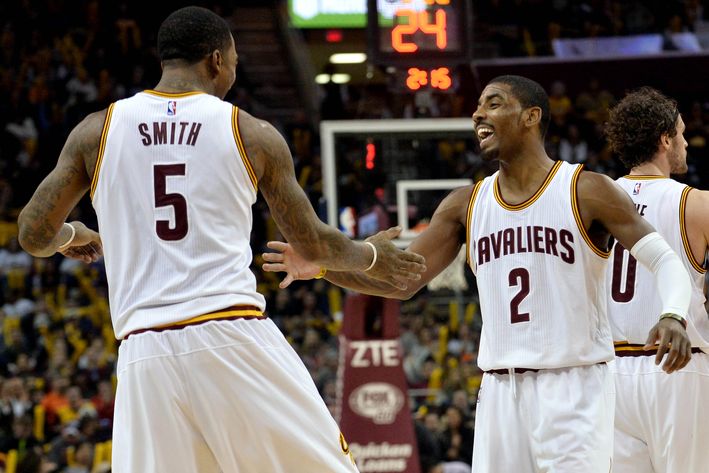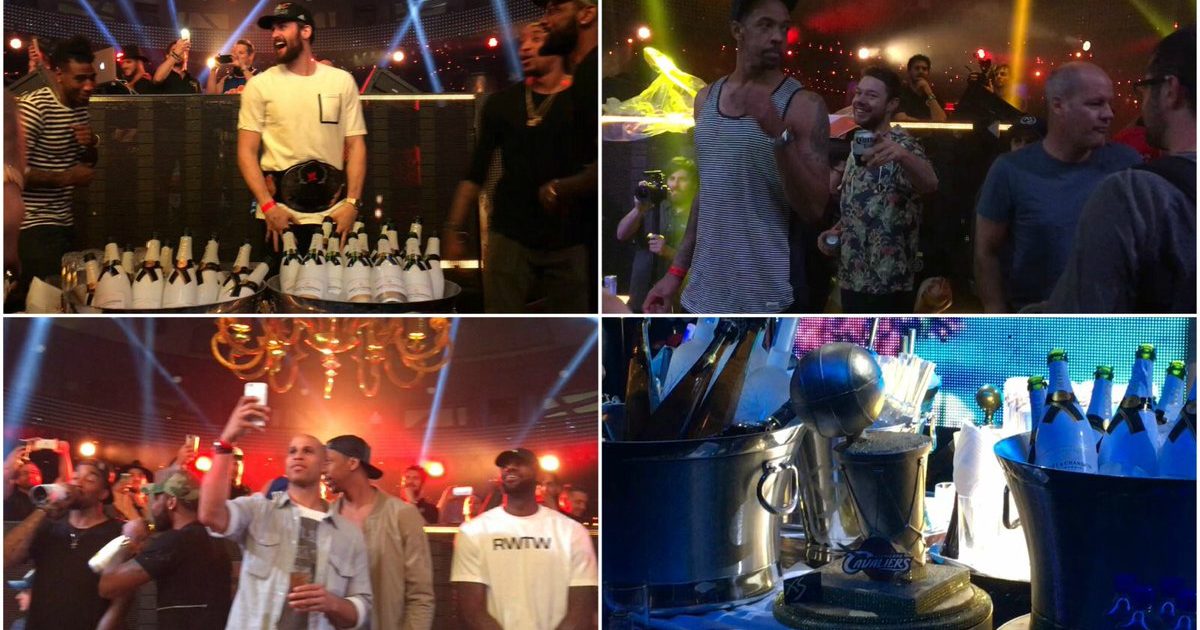
The Point Four-ward: Boys 2 Men
2016-08-24
Four points I’m thinking about the Cleveland Cavaliers…
1.) Cavs point guard Kyrie Irving has had quite a summer. After hitting the three-pointer that put the Cavs up for good in Game 7 of the NBA Finals, the newly-minted champion added “Gold Medal Winner” to his resume when the U.S. Men’s Olympic Basketball Team defeated Serbia in the gold medal game in Brazil 96-66.
While Golden State’s Kevin Durant was the clear M.V.P. for the U.S., Irving didn’t disappear during his first turn on the international stage. Irving, along with Carmelo Anthony, scored all but two of the team’s fourth quarter points as the U.S. pulled away from Australia, eventually winning 98-88.
Now, it’s time for Irving to get some much needed rest before he and his Cavs teammates start the defense of their title. While Cavs fans hope that the experience of playing for the U.S. team pushes on-court Irving’s maturation even further, others worry that not giving himself more off-season rest is a recipe for Irving, who has a history of getting hurt, to be more susceptible to injury in 2016-17.
While every player is different, I thought I’d look back at the point guards on the 2012 U.S. Men’s gold medal team just to see any reason for concern.
In 2012, Chris Paul was 27 years old, three years older than Irving is now. A knee injury forced Paul to miss 12 games during the 2012-13 season, a season in which he averaged the third least points per game (16.9) of his career. Deron Williams, however, played in 78 games that season and, at age 28 at the time, registered no significant down ticks in his performance as a member of the Brooklyn Nets (his drop-off would come the following season). And, as should come as a surprise to no one, Russell Westbrook played in all 82 games in 2012-13. Westbrook, 23 at the time, continued the upward trend in his play. However, Westbrook also suffered a knee injury in December 2013 that took him out of nearly half of the 2013-14 season.
So, if any Cavs fans are worried about Irving, a very small sampling of history shows that you should focus all your good vibes on his 2017-18 season. Otherwise, just look forward to seeing if Irving’s busy off-season helps him become an even better player now.
2.) There is one last piece of unfinished off-season business for the Cavaliers: re-signing swingman and Klutch sports client J.R. Smith. This is now the second year in a row that General Manager David Griffin and agent Rich Paul of Klutch have played a summer-long game of “which side blinks first.” Last year, it was Tristan Thompson‘s turn to get paid and this year’s Smith stalemate is looking a lot like a reboot of Thompson’s drawn out journey to the bank.
In mid-July, Paul was asking in the neighborhood of $15-million per for the Cavs’ sharpshooter. Recently, Basketball Insiders gave this update:
League sources said that Smith and his camp were not overly concerned about reaching a deal, with a belief that the Cavs have put a multi-year offer in the $10 million per year neighborhood on the table weeks ago. They added that Smith and his advisors have been looking for a slightly bigger offer and that waiting things out was simply about leverage and trying to get a slightly better deal.
While the amount of the deal is clearly at issue, exactly how “multi-year” the Cavs are willing to get surely is, as well. Of all of the hypothetical contracts tossed around, I’ve not heard one that goes beyond three years and many believe that third year will be one of the bigger issues left to resolve, with the Cavs unlikely to want to go beyond two-years guaranteed.
Thompson and the Cavs finally agreed on a deal on October 21, 2015. If you’re keeping score at home, that means we still have somewhere in the neighborhood of two more months of waiting before something gets done.
3.) The reasoning for keeping Smith on a shorter contract has to do with his age (he’ll turn 31 on September 9) but is often talked about more as being about his motivation. Dating back to 2012, when Smith returned to the U.S. after spending the lockout playing in China, teams have favored shorter contracts for Smith likely as a way to ensure the often mercurial player stayed focused. If Smith was always playing for his next contract, he was more likely to push himself to play at a high level.
The problem for Smith (and, perhaps, the Cavs) now is that he now has a track record of being a dependable, if streaky, member of a championship team. While the national view of Smith hasn’t changed as dramatically as it has to the Cavaliers and their faithful, people who know basketball recognize the kind of teammate Smith has been in Cleveland and just how important he has been to what they do on the court.
Smith is a a 6-6 guard with championship experience who can defend and finished in the the top 10 of three-pointers made hitting them at a 40% clip. In fact, those words, in some order, are probably the first out of Paul’s mouth when he meets with the Cavs. Griffin, meanwhile, would prefer not to pay $15-million a year to a guard in his 30s. While shooters generally age well, the Cavs need Smith’s athleticism as much as his shot… and that’s what will start slipping over the course of whatever contract he ends up signing.
So, while the Cavs will say it really is about age, Griffin can always fall back on Smith’s reputation and say, “Look, J.R. has always played better on short-term deals.”
If Smith’s maturation (if that’s the right word) had occurred a few years earlier, teams likely would have lined up to throw big money at him.
4.) But maturation isn’t an exact science. It happens at different times for different people, and there’s no denying that the life-span of an NBA career covers years where few people have reached peak maturity.
I was thinking about this last week as I was chewing through my vacation book, Jack McCallum’s Seven Seconds or Less about the 2005-06 Phoenix Suns. I finally got around to reading the book after listening to McCallum’s appearance on Zach Lowe’s The Lowe Post. In the podcast, McCallum talked about the difference between Amar’e Stoudemire‘s immaturity during the year McCallum covered the Suns and the cultured man of worldly interests Stoudemire would become over the course of his NBA career.
A current Cavalier even makes an appearance in the book, spoken of in a way that seems impossible now. Here’s the description:
He doesn’t work out in the weight room, believing that shooters can get too muscular, but his lack of strength is a problem. The Suns want him to do two things—catch and pass or catch and shoot—but too often he catches and dribbles, a skill at which he is not adept. Every time D’Antoni tells him he’s doing well, his play slacks off. And while he is a quiet and generally polite young man, he also has the knack of speaking up when he should remain silent.
Bet you’d never guess that’s how McCallum described a young James Jones.
Jones, of course, went on to be a beloved teammate of LeBron James, nicknamed “Champ,” and recently described by Kevin Love as “the best teammate I’ve ever had.”



Enjoyed this piece, Robert. I have a soft spot for JR because I love redemption stories. I have a bunch of Nuggets fan friends and they are blown away that he not only won a championship but was one of the key cogs. They’re incredulous. LeBron deserves some credit here, and maybe the Cavs’ culture under Grif. JR doesn’t get there playing with Melo. I think he’s going to have a fine finish to his career, with an episode here and there that will remind us of what he once was. But as you say, shooters generally age well, and… Read more »
blog clown aside(can a fan be a troll on his fav team’s site?), an article making an attempt to compare Kyrie Vs Curry. Agree with the final thoughts from the article. In short, it will be fun to watch Kyrie’s growth and Curry and Kyrie match ups for years to come. http://kingjamesgospel.com/2016/08/21/kyrie-irving-and-stephen-curry-career-breakdown/ Final Thoughts Kyrie Irving is not better than Stephen Curry. There is no feasible way that can be an argument. Curry is way more efficient as a scorer. However, it should make every fan wonder, is Kyrie really that far off from Steph? Can Kyrie grow into his… Read more »
Kyrie> Curry when it counts. We all just saw this. Quit trolling.
Also, Kryie’s defense in the Finals>>>Curry’s defense in the Finals.
Some of the writers have discussed the similarities between Kyrie and Steph on their podcasts. And they are really similar. I’d say the only difference is we’ve seen steph do it for a whole season and Kyrie do it in flashes. And Steph’s range is stoopid. But Kyrie could have a similar career arc if he gave a crap on defense for a whole season.
Kyrie is more careful with the ball and shows more control but Curry’s vision is underrated part of his game and quite frankly not exploited to fullest yet with Draymond as primary play maker last year. I think with Durant in the team, Curry will provide lot of highlights with the passing this year while also frustrating fans by turning over the ball at the same time. Kyrie can have similar career arc as Curry.
About Kyrie, it is a great turnaround story. This is the first year he finished healthy, I think, just 2nd year he made playoffs. If he didn’t finish healthy or Cavs lose finals at 1-3, there was a great chance that Kyrie would have been traded. From game 5 in finals though, Kyrie is on rise. If he continues the form, he will be a MVP candidate next year. Curry did win MVP after 2014 world cup. Was not a fan of him but he changed my perception of him over last two months, I wish him best.
Nope. He’s not a turnaround story. He’s been on an upward trajectory except for his injury in the Finals that caused the Cavs to lose. He would not have been traded (even though that would’ve made Nate really happy).
He just outplayed Fraud Boy, is younger than Fraud, and can turn it on in key moments on the biggest stage (unlike Fraud).
Couldn’t agree more Cols. Everyone attacks Kyrie’s defense, but the Cavs just beat the team with the best regular season record ever by simply hammering Curry’s defense (or lack thereof).
Meanwhile, Cavs still haven’t lost a playoff series with a healthy Kyrie.
Smith will probably Split the difference with a partially guaranteed third year: something similar to the deal the gave Andy. Maybe three years, 36 Mil, with a $4-5 year guarantee on year three.
Yep. No reason to worry about Smith. He will eventually sign for 3/45 or something in that neighborhood.